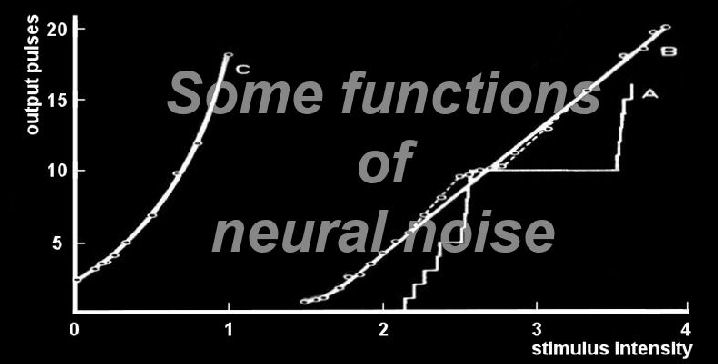| Response
of a neuron model to a 100 ms series of 10 pulses. Each pulse lasted 1 ms. Their intensity was changed: A. as such (without noise), B. with noise added, C. like B, but with decreased neuron thresholds. Noise increases the quality of the statistical stimulus response relationship: Noise increases as well as linearizes the range over which information is gathered and transmitted. After fig. 7 in: |
Reactie
van een modelneuron op een 100 ms durende reeks van 10 pulsen die elk 1 ms duurden en waarvan de intensiteit werd gevarieerd: A. zonder ruistoevoeging, B. met ruis toegevoegd, C. met dezelfde ruis plus een drempelverlaging. Hieruit is te zien dat ruis de kwaliteit van de statistische stimulus-respons relatie verbetert: Ruis vergroot en verfijnt het bereik waarover informatie over de stimulus wordt overgedragen. Naar fig. 7 in: |
|
H.E. Derksen,
1964. Discussion
in: Proc.
XXIIth Int. Congr. Phys. Sc. Vol. III,
384-394.
Amsterdam-New York, Excerpta Medica Foundation (see pp. 390-393). (PDF file) |
| Other examples: | Nog enkele voorbeelden: | |
| - Noise
increases neuronal sensitivity (1) - Noise creates spontaneous activity: - in some sensors where it acts as a carrier wave (3), - as well as in small neurons (2).
In this way these random processes
may thwart deterministic patterns and generate new ideas ( creativity ) and an original attitude ( "free will" ). This field of research is now covered by the name stochastic resonance or stochastic facilitation |
- Ruis
vergroot de gevoeligheid van neuronen (1) - Ruis creëert spontane activiteit: - in sommige sensoren waarin het werkt als een draaggolf (3), - en in kleine neuronen (2).
Op deze manier zullen deze toevals-
processen deterministische patronen kunnen doorbreken en daardoor aan- leiding geven tot nieuwe ideeën ( creativiteit ) en een eigen opstelling ( "vrije wil" ). Dit veld van onderzoek wordt tegenwoordig gedekt door de naam "stochastic resonance" of "stochastic facilitation". |
| 1. M. ten Hoopen
and A.A. Verveen, 1963. Nerve-model experiments on fluctuation in excitability. Progr. Brain. Res. 2, 8-21 2. A.A. Verveen, 1962. Axon diameter and fluctuation in excitability. Acta Morphol. Neerl. Scand., 5, 79-85. 3. A.A. Verveen and H.E. Derksen, 1965. Fluctuations in membrane potential of axons and the problem of coding. Biological Cybernetics, 2, 152-160. (PDF files) |
| See also: E. Sejdic & L.A. Lipsitz, 2013. Necessity of noise in physiology and medicine. Comput Methods Programs Biomed 111(2): 459-470. |
